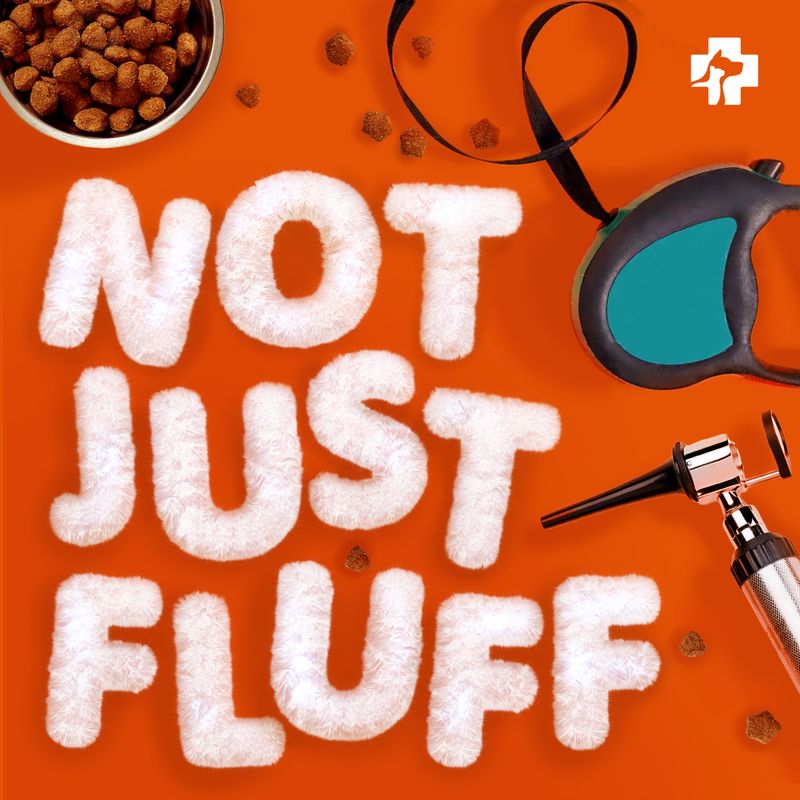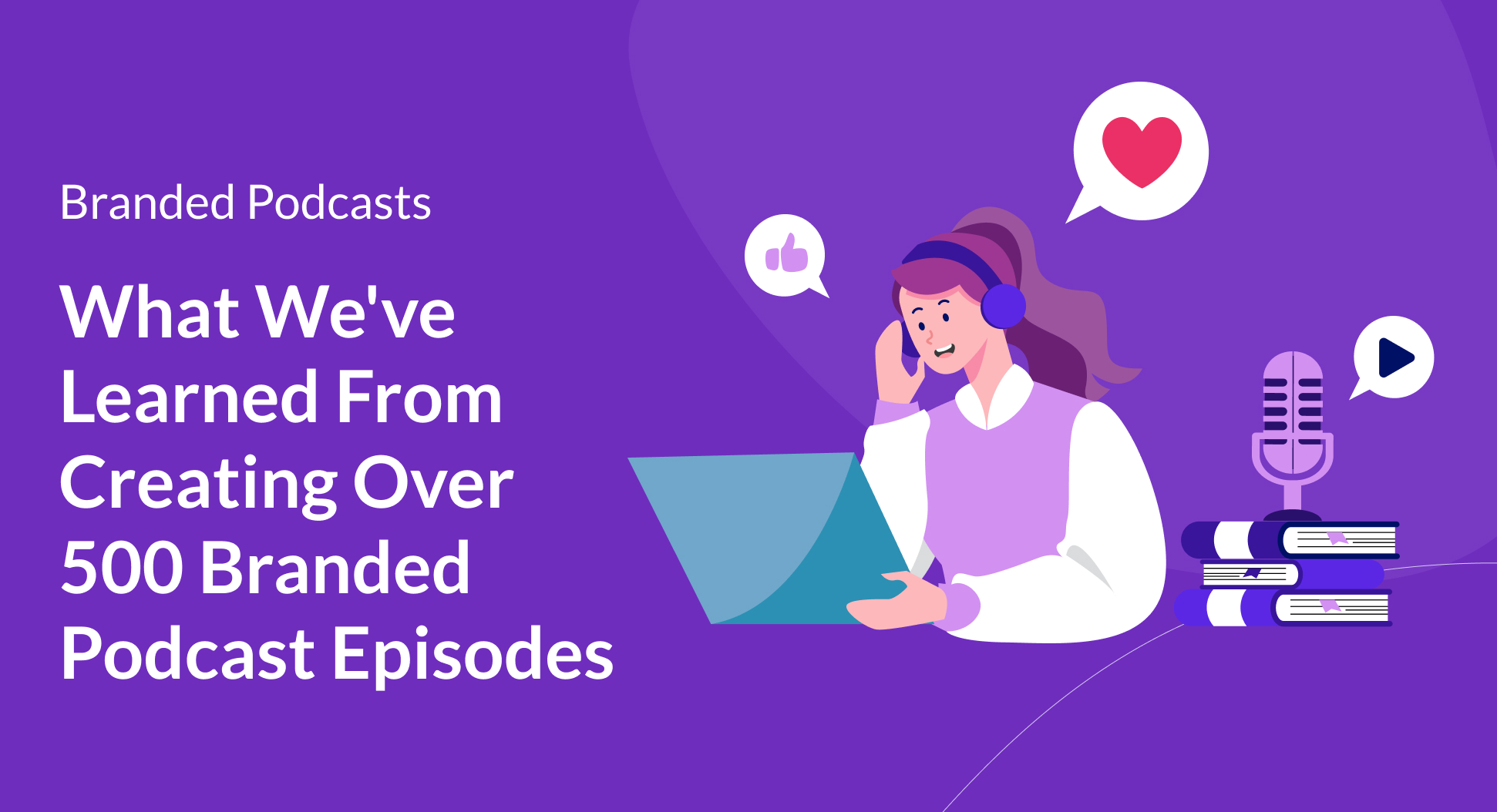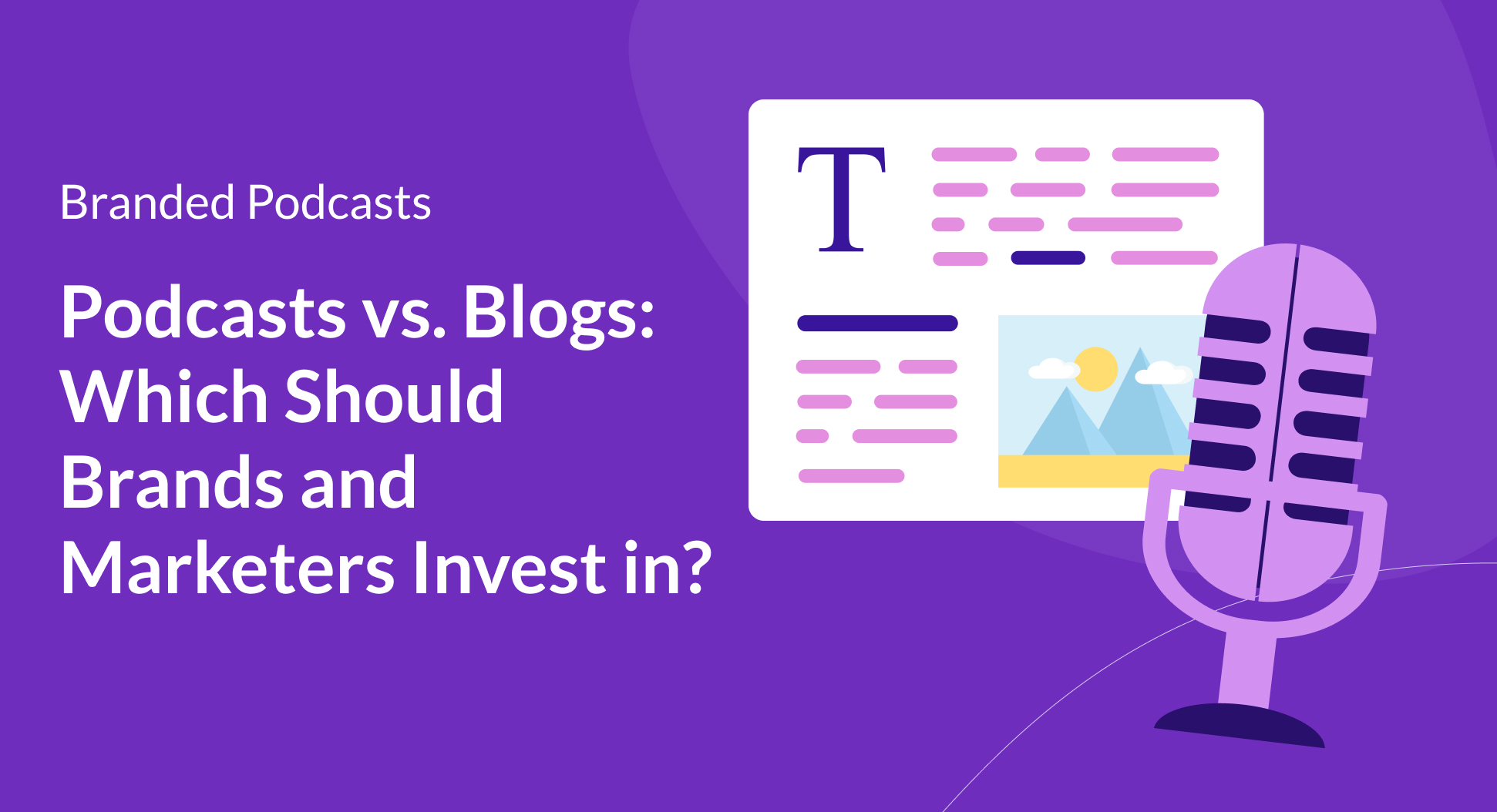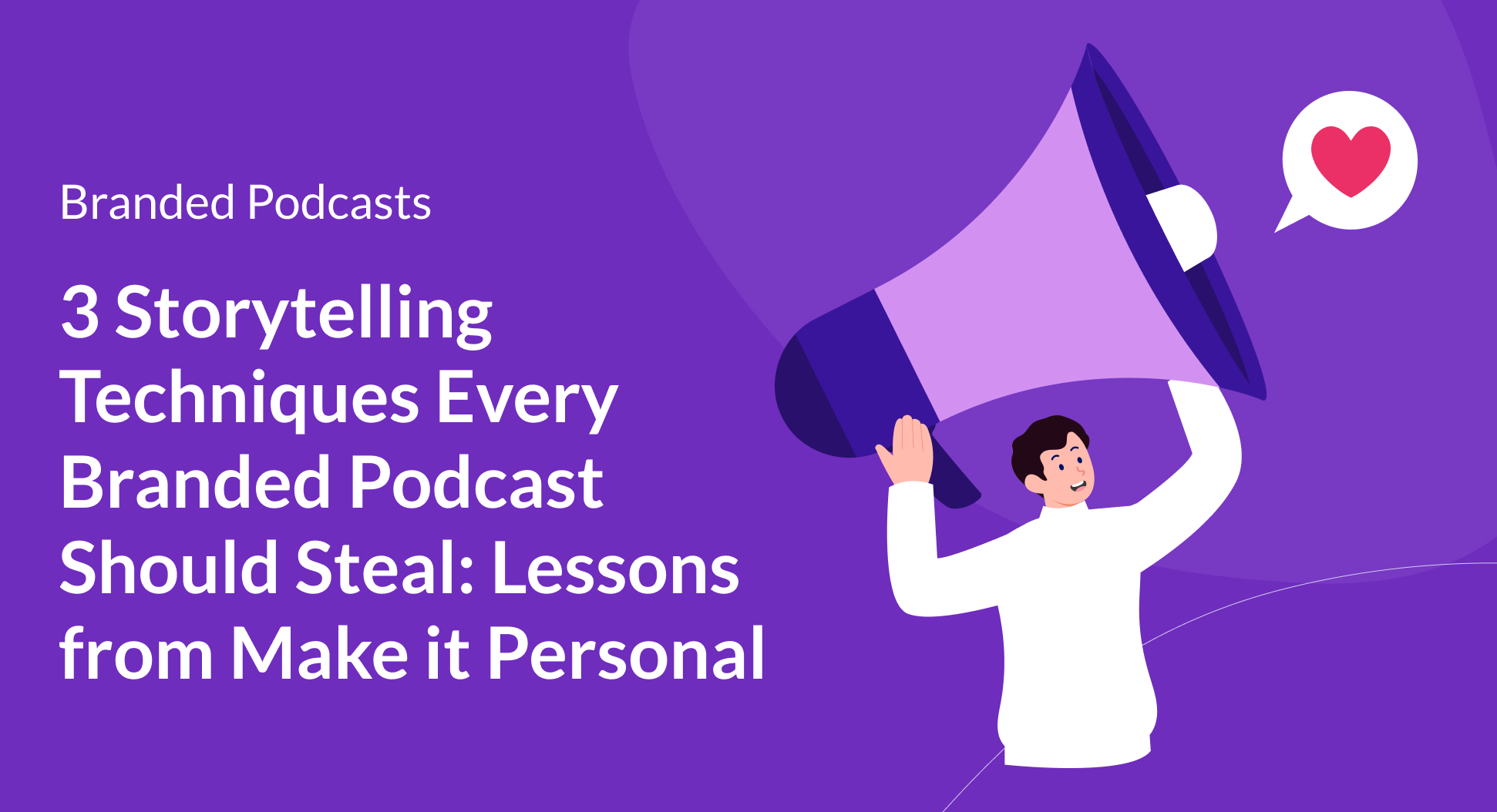Contents
Ever notice how some branded podcasts make you want to hit “next episode” while others make you question why they exist at all? Yeah — we’ve seen both.
After producing over 100 branded podcasts for global brands like Walmart, PwC, and Expedia, we’ve learned a thing or two (or, for the sake of this article, seven) about what actually makes a show stick.
And it’s not the celebrity host, the fancy mic, or even the ad budget. It’s the strategy, the story, and the staying power.
So, whether you’re a marketer planning your brand’s first show or you’re looking to sharpen your existing series, these are the lessons we’ve learned from helping some of the world’s biggest brands turn podcasts into powerful marketing engines. The kind that don’t just get heard, but remembered.
1. Branded doesn’t mean boring
Here’s the thing: the best branded podcasts don’t sound like they were made by a brand at all. They sound like something you actually want to listen to on your morning walk — not something you feel obligated to click because your company produced it.
The difference? Creative risk.
Playing it safe might keep your legal team happy, but it won’t earn you listeners. If you want people to tune in week after week, your podcast has to give them something bold, something fresh, and something that respects their time.
That might mean rethinking your host, loosening your tone, or breaking a few unspoken “rules” of branded content. Because the truth is, no one’s dying to hear another overly polished brand monologue.
Here are a couple of tips we have for making your podcast bold (not boring):
Choose a host outside your company
Just because your CEO is the head of your company doesn’t mean they should host your podcast. A great podcast host isn’t just knowledgeable — they’re engaging, curious, and authentic. Choosing an external host shows your audience you’re serious about creating something that’s worth their time, not just another piece of content.

For example, Not Just Fluff opted for host Hannah Shaw Banfield because of her unique blend of expertise, compassion, and reach: she’s not only a professional rescuer and humane educator but also a trusted voice in the pet community with a track record of making animal welfare approachable.
Break the branded content rules
Branded podcasts don’t all need to take the form of an expert interview with neatly packaged takeaways. Experimenting with format, tone, or structure can go a long way. Maybe that means leaning into a narrative approach, blending genres, or finding creative ways to bring your brand’s subject matter to life.

For example, when creating Momentum, the Canadian Olympic Committee took a bold, creative risk by shifting the spotlight away from medals and rankings and instead shining it on the emotional and personal journeys of their athletes. That said, you don’t have to reinvent the wheel to stand out; you just have to give listeners something valuable and unique.
2. Adopt an audience-first approach
In today’s crowded media landscape, attention is the most valuable currency — and it’s not given, it’s earned. Listeners have countless options competing for their time, from true crime series to comedy podcasts, bestselling audiobooks, and endless social media distractions.
If your show isn’t original, engaging, and relevant, it risks getting lost in the noise. With that said, here are some things to keep top of mind when creating your branded podcast:
Audiences aren’t given, they’re earned
When brands launch podcasts, there’s often an assumption that an audience will appear simply because the brand has followers, customers, or a reputation. The reality is that audiences are built — one episode at a time.
The content has to be compelling enough that people want to share it, recommend it, and return for more. That means crafting a show with structure, energy, and layers, rather than hitting“record and hoping your talking points land.
The best branded podcasts are from you, not about you
One of the most effective creative filters in branded podcasting comes from Steve Pratt: make your content from you, not about you.
- From you: Reflects your brand’s perspective, voice, and expertise. Your podcast should feel like something only your brand could produce — original, thoughtful, and distinct.
- Not about you: Avoid talking exclusively about your wins, products, or value propositions. Listeners aren’t tuning in for a sales pitch; they engage with content that offers insight, access, storytelling, or a fresh point of view with no strings attached.
When you shift the focus from your brand to your audience, both the content and the brand benefit. A good way to gauge this is by stepping back and asking yourself and your team:
- Are we providing unique value to our target audience?
- Would I listen to this podcast if I didn’t work here?
If the answer is yes to all of the above, your podcast is in a much stronger position to stand out.
“There is a tendency for marketers to feel that a podcast from a brand has to talk directly about the brand or the products and services offered. When we think about it from an audience perspective, though, very few people are eagerly waiting for any podcast from a brand, let alone a heavy-handed infomercial. And yet, when we watch or listen to our favorite shows, we know who made them. We know that HBO made Game of Thrones. We know that Gimlet made Startup. And we know that the New York Times makes The Daily. Make an amazing show that only your brand can make. Then, you don’t need to tell the audience who you are—they will already know and remember that it’s from you.”
–Steve Pratt, Fractional Creative Director at Quill and Author of Earn It
3. Don’t hyperfixate on the competition
One of the most common missteps in branded podcasting is obsessing over what competitors are doing. Brands see a rival releasing multiple episodes a week and immediately feel the pressure to match that output — without pausing to ask whether it actually makes sense for their own goals or audience.
Following the crowd may feel safe, but it rarely leads to differentiation. Trying to replicate someone else’s success often results in a product that’s predictable, forgettable, or just a slightly smaller version of something that already exists. In other words, being second, third, or tenth at doing the same thing rarely resonates.
The key to standing out is focusing on what only your brand can offer: a unique perspective, voice, or approach that aligns with your audience’s needs. That might mean experimenting with format, tone, or storytelling in ways competitors haven’t tried — and being willing to take thoughtful creative risks.
4. Marketing ≠ marketability
A good podcast on its own won’t automatically find an audience. You can have top-tier production, engaging hosts, and compelling guests, and still see your download numbers stagnate. The missing piece isn’t always marketing; it’s marketability.
Marketability comes first. A podcast has to earn its place in someone’s weekly rotation. That means asking tough questions before you even hit record:
- What are we making?
- Who is it for?
- Why is it meaningful or useful for them?
- Why does it make sense for us to produce it?
- Who is going to bring it to life?
The answers to these questions ensure your show is something the audience actually wants — not just a polished message for internal stakeholders. Without this foundation, marketing efforts are wasted trying to promote something people aren’t drawn to in the first place.
Marketing comes second — but it starts early. Marketing isn’t just a campaign you launch after the show is done. It’s about thinking from day one about how people will discover, engage with, and share your content. That means content creators and marketing teams need to collaborate throughout the production process, ensuring the show is both compelling and discoverable.
The brands that succeed in podcasting are the ones that treat marketability and marketing as twin priorities. They create shows that are inherently valuable to listeners and back them up with smart strategies to reach the right audience. In short: you need both sides of the coin to build a podcast that actually earns attention — and keeps it.
5. Nail your niche
In branded podcasting, trying to appeal to everyone usually means appealing to no one. Today’s listeners aren’t looking for broad, generic content — they want something that speaks directly to them, their interests, and their challenges. Niche podcasts deliver that level of relevance, connection, and engagement in a way mass messaging simply can’t.
Now I know what you’re thinking: shows with broad appeal like The Tim Ferriss Show or Armchair Expert have built massive audiences over the years. Yes, that’s true, but today it’s increasingly difficult for new shows to grow simply by casting a wide net.
Let’s take a look at the numbers:
- 60% of listeners say niche podcasts offer deeper value and insights than mainstream programming.
- 60% also report that they find niche podcasts more engaging.
- 59% feel a stronger connection and loyalty to niche podcasts.
- 63% say they are less likely to skip ads on niche podcasts compared to mainstream shows.
Consider this scenario: your branded podcast targets C-Suite executives at financial institutions. A hyper-focused show that speaks directly to their challenges might only attract 200 downloads per episode — but every single download comes from your ideal audience. A broader show could hit 5,000 downloads, but only 10 of those listeners are your target audience, and the rest are less relevant.
For brands, a small, highly engaged audience is far more valuable than a large, passive one. Niche podcasting prioritizes relevance over reach, helping brands create meaningful connections where it counts.
6. Podcast tracking doesn’t stop at downloads
Creating a podcast is one thing — proving it’s moving the needle for your brand is another.
To understand your podcast’s real impact, you need a data-driven approach that goes beyond vanity metrics and ties your show directly to audience engagement and business outcomes.
Just like a product launch, a branded podcast needs measurable goals. Tracking helps you:
- Prove ROI to leadership
- Identify what content resonates
- Improve future seasons
- Understand your audience on a deeper level
Now, when most brands think about podcast tracking, their minds typically go straight to downloads and subscribers.
While they’re easy to count, they’re often misleading:
- A download doesn’t mean a listener actually tuned in
- A subscriber doesn’t guarantee they’re engaged
To get actionable insights, focus on metrics that reveal real behavior: who’s listening, how long, and what they’re taking away. Here are some to keep in mind:
- Consumption rate: Measures the average percentage of an episode listened to. High rates (80%+) indicate content that holds attention; lower rates signal pacing or relevance issues.
- Completion rate: Tracks how many listeners finish an episode. Completion rates between 70–90% usually mean your show is compelling.
- Drop-off points: Shows where listeners stop listening. Use this data to adjust intros, guest segments, ad placement, or episode length.
- Social media metrics: Likes, shares, comments, and follower growth indicate audience engagement and how your content resonates beyond the podcast.
- Website metrics: Track visits, time on page, and conversions from podcast landing pages to see how your show drives business outcomes.
- Ratings & reviews: Direct listener feedback highlights what works and what doesn’t in your content.
- Audience demographics & psychographics: Age, income, lifestyle, values, and job roles help determine if your content is reaching the right people.
- Firmographics: For B2B shows especially, firmographics (industry, company, job role, seniority, etc.) add another layer of audience insight.
- Listener surveys: First-party surveys can supplement analytics to measure audience needs, content relevance, and opportunities for growth.
Tracking the right metrics ensures your podcast isn’t just another content experiment — it becomes a strategic asset, informing content decisions, marketing strategies, and business outcomes.
7. Extend your podcast beyond the airwaves
To maximize the impact of your content, your podcast needs to live beyond listening apps. Repurposing lets you stretch the lifespan of every episode, reach new audiences, and reinforce your brand across multiple channels.
Rather than starting from scratch, you leverage the same insights, stories, and interviews to amplify your reach and provide value beyond the original episode. Here are some popular ways we repurpose our clients’ shows:
- Transcriptions: Convert your audio into written text. This boosts accessibility, improves SEO, and provides content that can be edited into blog posts, articles, or social snippets.
- Blog posts & articles: Turn episode transcripts or highlights into structured, self-contained posts. These extend your reach, improve discoverability, and allow your audience to engage on their own schedule.
- Videos: Clip key moments or full interviews for YouTube or social feeds. Video expands reach, caters to viewers who prefer visual content, and performs well in search rankings.
- Audiograms: Short, shareable clips with waveform visuals and captions. Audiograms highlight compelling moments and attract attention on social media.
- Social media snippets: Extract quotes, insights, or highlights to share as images, carousels, or micro-videos. This engages audiences who might not listen to full episodes and encourages sharing.
For instance, NEI uses short video clips, audiograms, and carousel posts to engage their audience on LinkedIn and extend the life of each episode. Here’s an example:
For more ideas, our friends at CoHost put together a list of 80 ways to repurpose your podcast content.
Podcasting is a marathon, not a sprint
After producing over 100 branded podcasts, one thing is clear: success isn’t accidental. It comes from a thoughtful mix of strategy, creativity, audience insight, and measurement.
The lessons here are simple in theory but powerful in practice: take creative risks, focus on your audience, embrace niche relevance, track meaningful metrics, and make your content work harder through repurposing. Each of these elements ensures your podcast isn’t just heard — it’s remembered, shared, and acted upon.
At the end of the day, podcasting is a marathon, not a sprint. Listen to your audience, experiment, and focus on the metrics that matter.
For more branded podcast tips and strategies like these, keep up with us over at The Branded Podcaster – our bi-weekly newsletter.






.png)

.png)




.png)
.png)
.png)
.png)